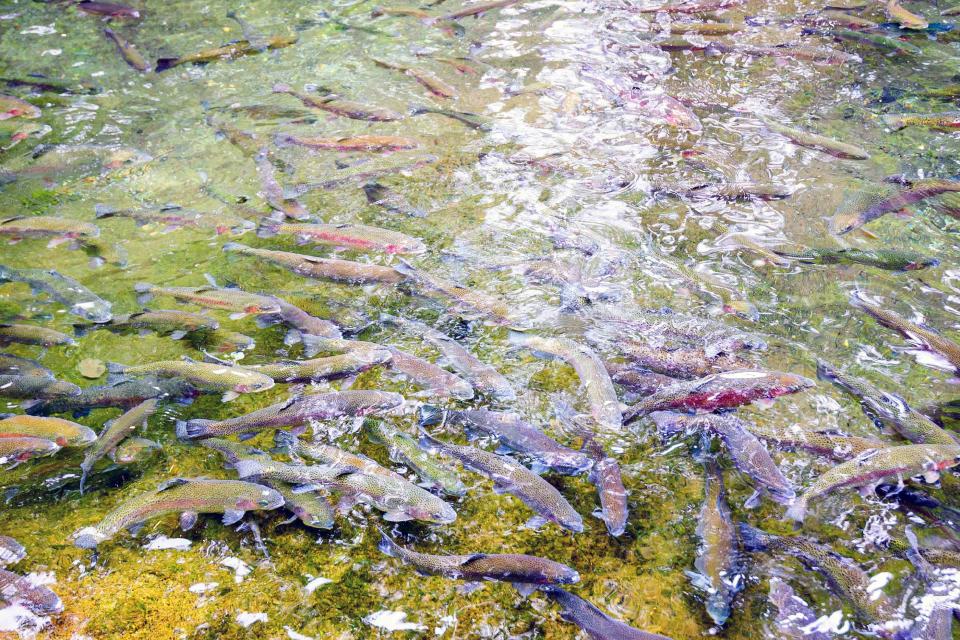How Beer Is Helping Salmon Find Their Way Home From the Ocean
A beer byproduct is being used as Google Maps for hatchery-raised salmon.

Getty Images
The Oregon Hatchery Research Center (OHRC), a collaborative project between the Oregon Department of Fish and Wildlife and Oregon State University’s Department of Fisheries and Wildlife, is constantly working on a number of crucial environmental objectives. One big part of its research involves working to both boost and protect the state’s salmon populations — and an Oregon brewery now has a role in this process, too.
For the past several years, one of the OHRC’s ongoing projects has been trying to find a scent that will help hatchery-raised salmon find their way back to the facilities where they were born, instead of mistakenly swimming into areas populated by wild salmon. If you’ve watched five minutes of a nature-related TV show, you’ve probably learned that adult salmon swim upstream, eventually returning to their original spawning grounds where they’ll lay their own eggs.
These incredible fish use their ultra-sensitive noses to track their way back by recognizing distinct scents from the waterways where they were spawned. “The repertoire of receptor genes in fish is smaller [than in dogs],” Marc A. Johnson, a fisheries and conservation biologist who works for the Oregon Department of Fish and Wildlife, told Oregon Live. “There are more aromatic molecules in air than are water soluble. There are hundreds for fish [to smell], but thousands for dogs; so a fish can’t smell as many things, but it can smell much better. It has to [quickly] know whether this is food or danger.”
Related: Beer Byproducts Are Hiding In Some Famous Danish Artworks
Shortly after they hatch, young salmon imprint on the scents that surround them and, when they get older, they’ll use the memory of those smells as kind of an olfactory Google Maps as they return to their birthplace. Johnson and a team of scientists and researchers have been trying to determine what scent (or combination of scents) could be used at salmon hatcheries so the fish born there can eventually find their way “home” too.
According to Hakai Magazine, some of the compounds that have been tested have included “extract of shrimp, tincture of watercress, skin of steelhead, and bile of minnow.” The researchers found a combination of amino acids that seemed to have a positive effect on the young fish, but it was too expensive to become a viable solution. That’s when Seth White, the director of the OHRC and a home brewer, suggested that brewer’s yeast contained a particular amino acid that young salmon can remember.
Earlier this year, White went to Rogue Ales brewery in Newport, Oregon, and left with a cooler filled with trub, a sludgy combination of unfermentable fats, coagulated proteins, and yeast that is leftover after the brewing process has finished. And although trub can by a messy byproduct of homebrewing — Hop Culture called it the “grossest part” of making your own beer — the salmon seem to like it.
Earlier this year, the National Oceanic and Atmospheric Administration (NOAA) and the University of Washington tested a trub-based scent on young hatchery salmon, and the initial results seemed promising. “We could see the introduction [of the beer-related amino acid cocktail] triggered immediate positive responses,” Johnson told Oregon Live.
Johnson and the OHRC team have received a grant so they can continue this beer-fueled research for the next two years, and it might take five to ten years to implement it in Oregon’s salmon hatcheries and determine its effects.
But until then, it can’t hurt to keep drinking Rogue Ales. They’re doing their part, so we should probably do ours, one Dead Guy IPA at a time.
For more Food & Wine news, make sure to sign up for our newsletter!
Read the original article on Food & Wine.

